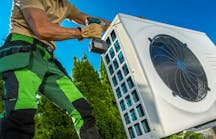A detailed radiant heating display helps customers understand how radiant works.
Jon Ryan, co-owner of Genz-Ryan, Burnsville, MN, calls the Genz-Ryan ' design studio' one of the most exciting developments he's ever been a part of at the 56 year-old heating, plumbing, cooling, and air quality company. More than just a showroom, the design studio — managed by Design Studio Manager Bridget Wenzel — displays working products in lifestyle situations, to explain to homeowners how comfort products can be integrated, and enhance their quality of life.
"We believe that HVAC and indoor air quality are extremely important, especially with energy costs increasing 50% or more per year over the last two years," says Ryan. "And, with all the selections a homeowner has to make during the building of their home, any simplification of the process will be welcomed."
Ryan says the fully functional display helps the company shine a spotlight on advanced HVAC controls, and helps people understand and appreciate all a quality home comfort system can do. Considering the company's background in plumbing, a variety of demonstration sinks and toilets are also available and operational.
"In a commodity industry, the design studio is a way to differentiate ourselves from our competitors," says Ryan of the wide array of demonstration models.
"Nobody was talking to home buyers about HVAC, and the plumbing wholesaler who would spec out the plumbing wasn't meeting our needs. So, when we made the move to a new facility, we decided to build the studio."
A family-owned business, Genz-Ryan, Burnsville, MN, was founded in 1950 by Louis and Greta Genz, Jon's father Jack Ryan, and grandmother, Rose.
Jack's wife Marge took an active role in the business in the late 60s. In 1997 sons, Dan, Mike, Bob, and Jon assumed leadership of the company. virtually all of the company's sales come from new home installations.
The Time was Right
Genz-Ryan's move towards a greater appreciation for advanced HVAC controls — that is, combining heating, cooling, and indoor air quality (IAQ) with electronic air filters and zoning — became a reality once the technology reached what the Ryan brothers believed to be an appropriate level of sophistication and user-friendliness.
"With the combined expertise of companies such as Honeywell, Lennox, Wirsbo, and other manufacturers, a contractor can usually proceed with confidence," says Ryan.
"If Honeywell can design missile guidance systems, I think they can handle home comfort. Honeywell has what we believe to the user-friendliest equipment.
"In many new homes you find one control for thermostat, one control for the humidifier, and one control for the HRV (air exchanger). But the Honeywell 8150 control marries them all into one. You set your square footage, number of bedrooms, and the CFM you need, and you're done. It's a learning system. You don't have a situation in which the HRV and humidifier are fighting each other."
Ryan is equally impressed by the way in which residential heating, cooling, and IAQ components have evolved along seemingly parallel paths, in a way that makes it much easier to integrate them into a total system.
Explain HVAC and You'll Win Them Over
To win customers and real estate agents over to the value and importance of HVAC in homes, contractors have to make it a priority talking point, and explain it in a way that's easy to understand, to both buyers and real estate agents.
In sharp contrast, Ryan recalls a story told to him by a purchasing agent from one of the area's major builders:
"The purchasing agent was walking through one of the home models at the same time a real estate agent was showing the home to prospective buyers. When it came time to show the buyers the mechanical room, the agent opened and shut the door very quickly, so as not to be asked many questions about HVAC.
"HVAC isn't flashy, it's somewhat complicated, and people don't like to talk about what they don't understand," says Ryan, so it's up to the contractor to make it user-friendly and non-technical.
The 'Perfect' Controls Customer
Ryan has yet to strike a chord in every single homebuyer who looks at the array of advanced controls the design studio offers. He says the "perfect controls customer" is the customer who not only appreciates the technology, but can also afford it.
"Customers with lots of money don't have a lot of time, and are not quite as sophisticated and comfortable with the technology," explains Ryan. "Whereas, younger people have more time and are more comfortable with the technology, but it's not yet affordable for them."
Ryan believes building controls will become more affordable for all homes over time.
"Soon we'll be installing Cat. 5 cable behind the walls, because it's all going to be integrated," Ryan says, and adds that the controls revolution will be complete when advanced technology becomes cost effective, easy to use, and reliable.
"We're getting closer in all three areas," Ryan exclaims. "It'll be complete in next five to 10 years."
|
Automation Improves Humidity Control Those controls can meet the needs of customers who want not only comfort, but who are also concerned about the damage that can be caused by low or high humidity. "People are seeking better control of indoor humidity to protect the thousands of dollars they're putting into their woodwork and home furnishings," says Sigman."That's why we began to investigate how we could expand our use of controls, such as the programmable thermidistat from Bryant. It uses outdoor temperature to control indoor humidity; it changes as the outdoor temperature drops, and the thermostat controls the humidifier." For most projects, Sigman integrates radiant and geothermal heating with zone controls, fans, and indoor air quality components. Bryant, Arzel, Fantech, TACO, ClimateMaster, Honeywell, Tekmar, and Johnson Controls are among the manufacturers he believes are taking integrated controls into new and different areas of home comfort. Looking ahead, Sigman hopes manufacturers will soon devise a way to control humidity through a home automation system, independent of a thermostat. "We can tie the thermostats in, and monitor temperatures from home automation systems, but we can't control humidity from a home automation control." |









